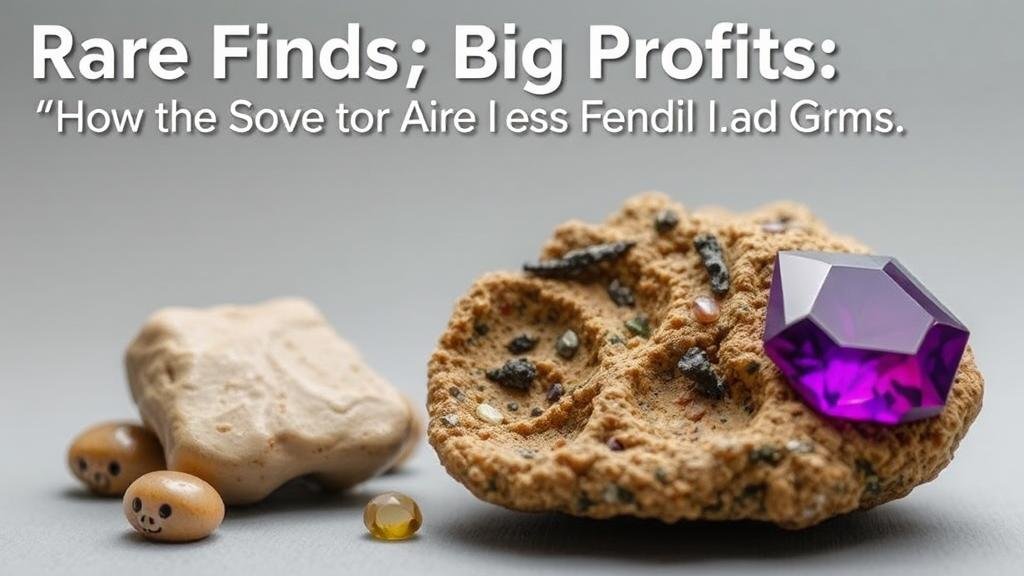Rare Finds, Big Profits: How to Spot the Most Valuable Fossils and Gems
Rare Finds, Big Profits: How to Spot the Most Valuable Fossils and Gems for Rockhounds and Mineral Collectors
The world of rockhounding and mineral collecting offers enthusiasts the opportunity to uncover rare treasures from the Earth. From spectacular gemstones to ancient fossils, the allure of these natural wonders can not only provide personal satisfaction but can also yield significant profits. Understanding how to identify and assess the value of these finds is crucial for collectors aiming for success in this fascinating hobby.
Understanding Value in Fossils and Gems
To effectively spot valuable fossils and gems, it’s important to understand what makes a specimen desirable. primary factors contributing to value include rarity, condition, size, origin, and market demand. For example, a well-preserved dinosaur bone can fetch tens of thousands of dollars, while a common fossil like a trilobite may only be worth a few dollars. Similarly, a flawless diamond can command a price of over $15,000 per carat, while an imperfect stone may be valued significantly less.
Types of Valuable Fossils
Collectors often seek out fossils that are not only rare but also exhibit exceptional preservation or unique attributes. Some of the most sought-after fossils include:
- Amber: Fossilized tree resin that sometimes contains prehistoric insects, making it highly valuable.
- Dinosaur Bones: Particularly those that are over 66 million years old and come from significant fossil beds, like the Hell Creek Formation in Montana.
- Ammonites: Extinct marine mollusks that are prized for their intricate, spiral shells.
- Fossil Shark Teeth: Teeth from prehistoric sharks like the Megalodon are rarer and command higher prices in the collectors market.
Identifying High-Value Gems
When it comes to gemstones, certain characteristics can dictate their worth. Values can vary dramatically based on the following:
- Color: Stones like sapphires and emeralds are most prized in rich, deep colors. For example, a vivid blue sapphire can be valued at over $11,000 per carat.
- Clarity: The presence of inclusions or blemishes can drastically decrease a gems value. Gemological Institute of America (GIA) rates diamonds and gemstones on a scale where Flawless is the highest grade.
- Cut: The craftsmanship of the cut affects how a gem interacts with light. A well-cut gemstone will have more brilliance and fire, increasing its value significantly.
- Carat Weight: Larger stones are rarer, and thus more valuable. For example, a one-carat diamond can typically be worth 2 to 3 times more than a half-carat diamond.
Research and Resources for Collectors
Knowledge is an indispensable tool for any collector. Use various resources to enhance your understanding of valuable fossils and gems. Some recommendations include:
- Purchasing field guides specific to your interest in fossils or gems.
- Joining local or online rockhounding clubs to share knowledge and experiences.
- Attending gem and mineral shows to network and discover new trends in the collecting community.
- Using online auction platforms like eBay to gauge market prices for similar items.
Practical Tips for Spotting Rare Finds
Here are some actionable strategies to increase your chances of finding valuable fossils and gems:
- Pay Attention to Location: Certain areas are known for specific types of fossils or minerals. Research locations, such as Beringer’s Quarry for fossils or Arkansas for diamonds.
- Know the Season: The best time to hunt for fossils is often after heavy rain, which can expose new finds. Similarly, certain gems can be easier to see and identify when conditions are optimal.
- Use the Right Tools: Equip yourself with essential tools such as hammers, chisels, geologists pick, and safety goggles when hunting for specimens.
Maintaining and Selling Your Finds
Once you’ve acquired valuable specimens, proper care is essential to maintain their integrity and value. Here are a few tips:
- Cleaning: Use gentle methods like brushing with a soft toothbrush or rinsing with water to prevent damage.
- Storage: Store your specimens in a cool, dry place, ideally in individual containers to avoid scratches or breakage.
- Selling: When ready to sell, get your items appraised by a certified gemologist or paleontologist to ensure you receive a fair price.
To wrap up, spotting valuable fossils and gems requires a combination of knowledge, research, and practical field skills. By understanding what makes specimens noteworthy, and employing effective strategies for collecting and caring for your finds, you can maximize both your enjoyment of the hobby and your potential for profit. Remember, the thrill of the hunt is often as rewarding as the find itself!



